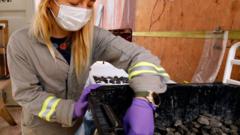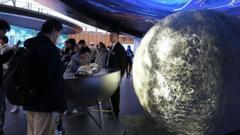In Hanover, Germany, the world of humanoid robotics is at the forefront, with the Unitree G1 captivating attendees at Hannover Messe. This compact and cost-effective robot showcases remarkable motion and has gained popularity through viral videos, but significant challenges remain before these machines can enter homes or workplaces safely.
Race for the Future: The Quest for Humanoid Robots

Race for the Future: The Quest for Humanoid Robots
The competition intensifies among firms developing humanoid robots as advancements in AI and manufacturing evolve.
As I walk through the bustle of Hannover Messe, a vibrant spring sun beams down, and the excitement around humanoid robots is palpable. Today, I have the unique opportunity to observe the G1, a humanoid robot designed by the Chinese company Unitree. Standing at a modest height of 4'3" (130cm), the G1 is not only more accessible in terms of cost compared to its competitors but also boasts an impressive range of mobility, captivating audiences with its dance routines and martial arts skills that have gone viral.
Manipulated remotely by Pedro Zheng, the Unitree sales manager, the G1’s enchanting interaction with visitors is striking. They instinctively reach out for a handshake or perform playful gestures to engage an otherwise lifeless machine. Its humanoid appearance creates a level of comfort and fascination that many other technological models fail to achieve. However, it’s essential to note that the G1's capabilities extend only to programmed responses, as it lacks true autonomous functions.
Unitree represents just a fraction of the global landscape where companies are racing toward creating human-like robots. The allure of humanoid robots lies in their potential to revolutionize the workforce—eliminating the need for breaks and salary hikes. Furthermore, the imagination is sparked by the idea of having these robots perform household chores such as laundry and dishwashing. However, despite the enthusiasm, experts caution that the technology has not reached a level of sophistication necessary for practical use in homes or unpredictable environments.
The logistics of integrating robots into everyday spaces, such as restaurants or homes, are complex, partly due to concerns about safety. Those aiming to develop humanoid robots face the dilemma of creating machines strong enough to perform tasks yet safe enough to prevent harm. As a spokesperson from Unitree conceded, “Today's robot AI finds basic logic and reasoning—a challenge,” highlighting the gaps still present in artificial intelligence that affect autonomous functioning.
Currently, the G1's market primarily targets research groups and tech firms which can utilize Unitree's software in their pursuits. The focus of many businesses now is on humanoid robots tailored for industrial environments, with notable figures like Elon Musk spearheading efforts through Tesla's development of the Optimus robot, expected to number in the thousands.
Other automotive manufacturers, such as BMW and Hyundai, are similarly investing in humanoid technology, hoping to advance their factories' efficiency with these innovations. Research indicates that more than 49 companies are actively developing humanoid robots, and if one broadens the definition slightly, that count exceeds 100.
The market appears skewed towards Asian firms, particularly in China, where strong government support propels the humanoid robot sector forward. Data from STIQ notes that nearly 60% of funding in humanoid robotics flows from Asia, solidifying the region's pivotal role in shaping the industry's future.
For Western companies, the competition is stiffer given the logistical challenges. Bren Pierce, a robotics entrepreneur from Bristol, highlights how manufacturing costs rise due to the dependence on components sourced from Asia, exacerbating competitive disadvantages. Instead, his latest project, the KR1 robot—designed for factory use—steers clear of traditional humanoid features, opting instead for a simpler structure.
By incorporating commercially available components into the KR1's design, Pierce aims to simplify the technology, allowing average workers to adapt to its use quickly. The quest for an all-encompassing humanoid robot may still be many years away, yet the potential of current technology keeps dreams alight among developers. "I do think that is the end goal," he muses, noting that significant advancements will take time to accomplish.
As we watch the evolution of humanoid robotics unfold, the road to an era where these robots seamlessly integrate into our daily lives remains long and complex—one that will require further innovation and trial over the coming decades.
Manipulated remotely by Pedro Zheng, the Unitree sales manager, the G1’s enchanting interaction with visitors is striking. They instinctively reach out for a handshake or perform playful gestures to engage an otherwise lifeless machine. Its humanoid appearance creates a level of comfort and fascination that many other technological models fail to achieve. However, it’s essential to note that the G1's capabilities extend only to programmed responses, as it lacks true autonomous functions.
Unitree represents just a fraction of the global landscape where companies are racing toward creating human-like robots. The allure of humanoid robots lies in their potential to revolutionize the workforce—eliminating the need for breaks and salary hikes. Furthermore, the imagination is sparked by the idea of having these robots perform household chores such as laundry and dishwashing. However, despite the enthusiasm, experts caution that the technology has not reached a level of sophistication necessary for practical use in homes or unpredictable environments.
The logistics of integrating robots into everyday spaces, such as restaurants or homes, are complex, partly due to concerns about safety. Those aiming to develop humanoid robots face the dilemma of creating machines strong enough to perform tasks yet safe enough to prevent harm. As a spokesperson from Unitree conceded, “Today's robot AI finds basic logic and reasoning—a challenge,” highlighting the gaps still present in artificial intelligence that affect autonomous functioning.
Currently, the G1's market primarily targets research groups and tech firms which can utilize Unitree's software in their pursuits. The focus of many businesses now is on humanoid robots tailored for industrial environments, with notable figures like Elon Musk spearheading efforts through Tesla's development of the Optimus robot, expected to number in the thousands.
Other automotive manufacturers, such as BMW and Hyundai, are similarly investing in humanoid technology, hoping to advance their factories' efficiency with these innovations. Research indicates that more than 49 companies are actively developing humanoid robots, and if one broadens the definition slightly, that count exceeds 100.
The market appears skewed towards Asian firms, particularly in China, where strong government support propels the humanoid robot sector forward. Data from STIQ notes that nearly 60% of funding in humanoid robotics flows from Asia, solidifying the region's pivotal role in shaping the industry's future.
For Western companies, the competition is stiffer given the logistical challenges. Bren Pierce, a robotics entrepreneur from Bristol, highlights how manufacturing costs rise due to the dependence on components sourced from Asia, exacerbating competitive disadvantages. Instead, his latest project, the KR1 robot—designed for factory use—steers clear of traditional humanoid features, opting instead for a simpler structure.
By incorporating commercially available components into the KR1's design, Pierce aims to simplify the technology, allowing average workers to adapt to its use quickly. The quest for an all-encompassing humanoid robot may still be many years away, yet the potential of current technology keeps dreams alight among developers. "I do think that is the end goal," he muses, noting that significant advancements will take time to accomplish.
As we watch the evolution of humanoid robotics unfold, the road to an era where these robots seamlessly integrate into our daily lives remains long and complex—one that will require further innovation and trial over the coming decades.




















